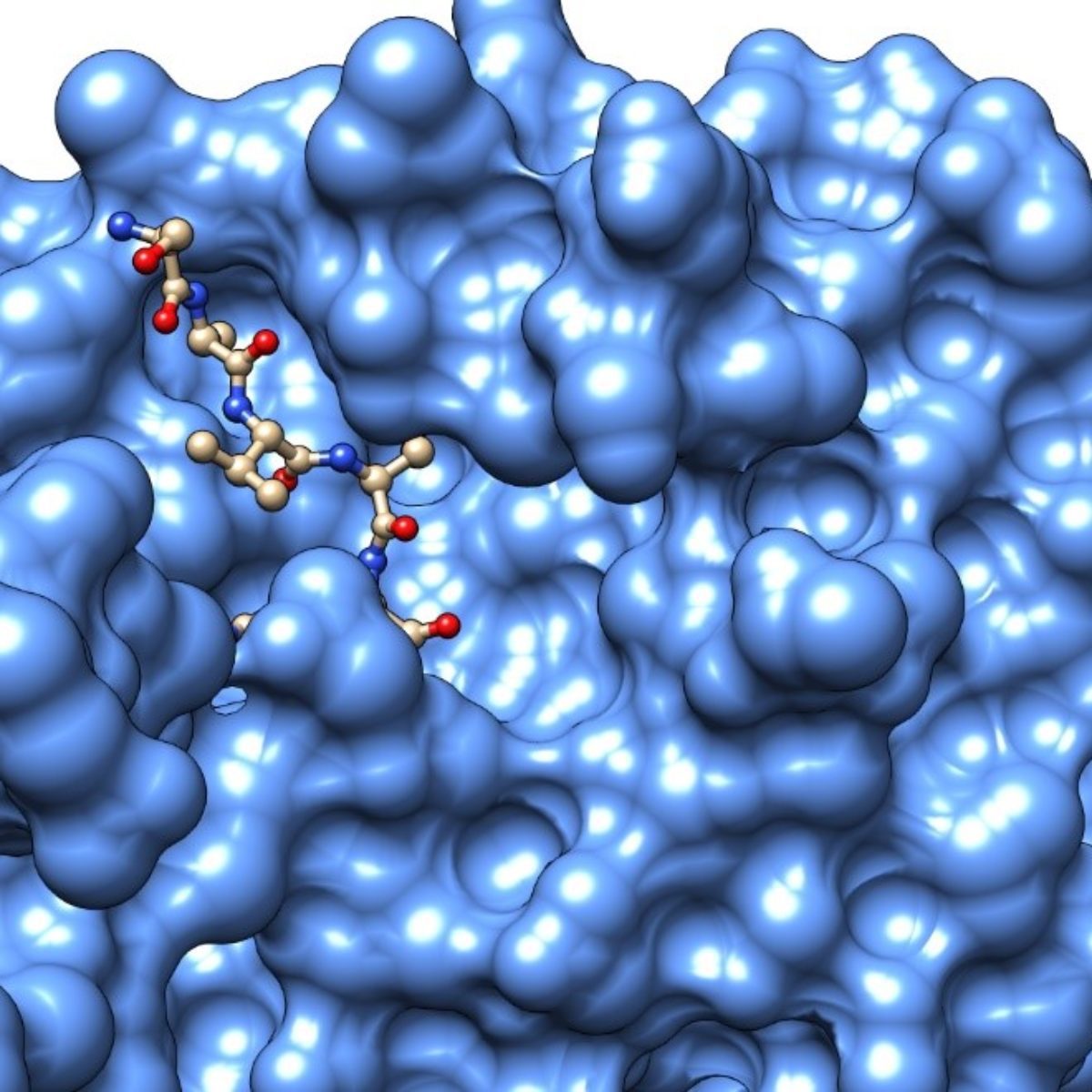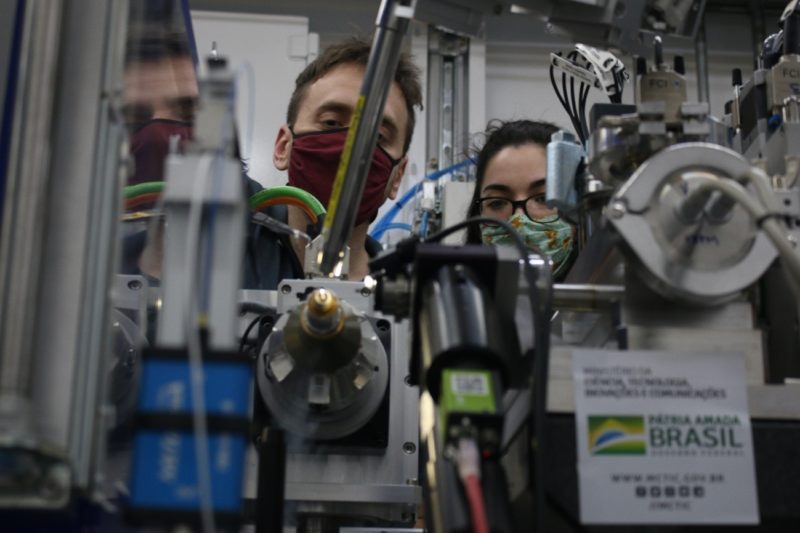
Final model of the peptide-linked SARS-CoV-2 virus MPro protease. Credits: André Godoy
Paper, which is part of the special issue of the Journal of Molecular Biology, reveals unprecedented details of the maturation process of the main protease of the SARS-CoV-2 virus
The first study with data collected by researchers using Sirius has just been published. Sirius is the state-of-the-art synchrotron light source of the Brazilian Center for Research in Energy and Materials (CNPEM), a private non-profit organization under the supervision of the Brazilian Ministry of Science, Technology, and Innovations (MCTI). The work, published in a special issue of the Journal of Molecular Biology, reveals details of the maturation process of the main protease of the SARS-CoV-2 virus.
In September 2020, when the first of Sirius’ research stations, named MANACÁ, was still in commissioning phase, a group of researchers from the University of São Paulo (USP) brought to CNPEM about 200 protein crystals of the SARS-CoV-2 virus to be analyzed in the beamline. The goal was to find, in the structure of proteins, possible targets to interrupt the virus’s life cycle by their binding to other molecules, which can give rise to new drugs. Ten months later, the first scientific paper with the results of this study has been published.
MANACÁ was the first research station at Sirius to receive external researchers, still during its scientific commissioning phase, as an emergency response to the pandemic. It is a beamline designed for X-ray diffraction protein crystallography experiments. “MANACÁ allows us to identify the position of each of the atoms in a biological molecule sample, such as proteins from the SARS-Cov-2 virus, to understand their morphology and investigate their mechanisms of action, and their interactions with other molecules with potential for drug development”, details Ana Carolina Zeri, a CNPEM researcher who coordinates the MANACÁ beamline.
The study
When the SARS-Cov-2 virus enters the cell, it hijacks the cellular machinery and tries to replicate itself, making more viruses. “But that by itself doesn’t make a virus ready to infect other cells, the virus makes its proteins in a single block, which we call polyprotein”, explains Prof. Glaucius Oliva, coordinator of the research group that carried out the first data acquisition at MANACÁ. “A part of this block is the protease, and its function is to transform this polyprotein into the virus’ parts that, when joined together, can reproduce many copies of the viral genome and envelope proteins and thus generate new viruses that are capable of infecting others cells. Our objective is to stop this process right at the beginning of the protease’s action and thus prevent the production of new viruses in the infected cells”.
Therefore, the main targets of the team’s study were the proteases, and Sirius made it possible to understand the processes of this protease’s previously unknown metabolism. Among them, it revealed that, for the protease Mpro (also called 3CLPro) to reach its mature form, it needs to temporarily bind to other copies of itself, either in the same state of maturation or more mature.
According to Andre Godoy, one the researchers responsible for the experiments carried out at Sirius, from the data collected the team obtained detailed information about the intermediate forms that the main protease of SARS-CoV-2 presents throughout its maturation cycle inside the cells, which is essential for the development of new antiviral strategies: “We used MANACÁ to characterize, in an unprecedented way, the multiple forms that the Mpro protease acquires throughout its self-maturation process. Furthermore, we identified how small chemical fragments bind at specific points of one of these new forms of the SARS-CoV-2 enzyme, which has less than 1% of the activity of the mature form”, he explains.
The group has in its hands more data acquired at Sirius and is working on finding molecules that can act as inhibitors of the most important proteases in the replication of viruses such as SARS-CoV-2. “Each of these proteins tells us a story. Each virus protein goes through a series of internal processes that have a certain activity. Not all of them are well described. Our biggest effort is to find a molecule that inhibits both proteases, PLpro and Mpro. We have plans for a molecule that can inhibit both, which is unprecedented.”
Sirius vs. SARS-CoV-2
Early access to Sirius was part of CNPEM’s collective efforts to provide the Brazilian scientific community with cutting-edge resources for studies that could contribute to strategies to fight the pandemic. “Even with the difficulties of remote work and shifting teams, everyone made the best effort. We knew of the importance of MANACÁ for coronavirus studies and we were very happy to be able to contribute to the understanding of the virus’s biology”, says Andrey Nascimento, one of CNPEM’s researchers that operates the MANACÁ beamline.

Researchers André Godoy and Aline Nakamura position a SARS-CoV-2 protein crystal for analysis at Sirius in September 2020. Credit: CNPEM.
For Lucas Sanfelici, head of Sirius’ beamline engineering division, MANACÁ is emblematic both for the great effort and commitment of the team in the face of the challenges brought by the pandemic and for the installation, integration, and operation of a series of complex equipment developed internally. “It was the ‘first time’ for many people, with many systems being developed simultaneously. It had everything to be a longer process, but the desire to see this work of years coming to life to help in the fight against COVID-19 boosted this result.”
But there is still a lot of work to be done, as highlighted by Harry Westfahl Jr., Director of the Brazilian Synchrotron Light Laboratory (LNLS/CNPEM): “The expectation is that soon we will be able to open five more beamlines so that users can conduct their research and, depending on budget resources, another eight stations should be set up next year”. The next beamlines to be opened to researchers will support frontier scientific research with the potential to benefit areas such as agriculture, the environment, energy and new materials, as well as health.
About Sirius
Funded by MCTI, Sirius is one of the most advanced synchrotron light sources in the world. This great scientific equipment has at its core state-of-the-art electron accelerators for generating synchrotron light, a kind of electromagnetic radiation capable of revealing the microstructure of organic and inorganic materials. These analyses are carried out at research stations called beamlines. Sirius will support several beamlines, optimized for different experiments, and that operate independently of each other, allowing different groups of researchers to work simultaneously, in different researches in a wide range of fields, such as health, energy, new materials, environment, among others.
The different experimental techniques available on Sirius’ beamlines will allow us to observe microscopic aspects of the materials, such as the atoms and molecules that constitute them, their chemical states, and their spatial organization, in addition to monitoring the evolution over time of physical, chemical and biological processes that occur in fractions of a second. In a beamline, it is also possible to follow how these microscopic characteristics change when the material is subjected to various conditions, such as high temperatures, mechanical stress, pressure, electric or magnetic fields, corrosive environments, among others. This ability is one of the main advantages of synchrotron light sources when compared to other high-resolution experimental techniques.
Sirius’ beamlines are advanced scientific instruments, designed to solve problems in strategic areas for the development of Brazil. Initially, a set of 14 beamlines is planned to cover a wide variety of scientific programs. Altogether, Sirius will be able to house up to 38 beamlines.
About CNPEM
A sophisticated and effervescent research and development environment, unique in Brazil and present in few scientific centers in the world, the Brazilian Center for Research in Energy and Materials (CNPEM) is a private non-profit organization under the supervision of the Brazilian Ministry of Science, Technology, and Innovations (MCTI).
The Center operates four National Laboratories and is the cradle of the most complex project in Brazilian science – Sirius – one of the most advanced synchrotron light sources in the world. CNPEM brings together highly specialized multi-thematic teams, globally competitive laboratory infrastructures open to the scientific community, lines of research in strategic areas, innovative projects in partnership with the productive sector, and training for researchers and students. The Center is an environment driven by the search for solutions with an impact in the areas of health, energy, environment, new materials, among others.
The unique and complementary skills present at CNPEM encourage research and development in the areas of synchrotron light; accelerator engineering; discovery of new drugs, including from plant species of Brazilian biodiversity; molecular mechanisms involved in the onset and progression of cancer, heart disease, and neurodevelopment; functionalized nanoparticles to fight bacteria, viruses, cancer; new nanostructured sensors and devices for the oil and gas, and health sectors; biotechnological solutions for the sustainable development of advanced biofuels, biochemicals, and biomaterials.
Abstract submissions are until August 20.
Registrations with abstract submissions are from 19 April to 23 May, 2021.